A NAME="Rubaka">
2024 - "made in Ukraine" drones
|

Rubaka ukrainian drone |
Since 2022, Kiev has internally developed "kamikaze" drones capable of reaching Russian rear bases without US or UE approval.
The Rubaka is a small drone that can fly up to 500 km and carry a 10 kg explosive charge. It is often used in squadrons to cause more significant damage.
In addition to the already mentioned Vampire drone, other drones like the Morok (3 m by 2.5 m) and the Liutyi (4 m by 7 m) can fly much furtherr, up to 1,000 kilometers for the first, and well beyond for the second, which puts Moscow within striking range of kyiv. Other models, with an even greater range, are being developed, in parallel with an increase in production rates.
The target is to produce 30,000 of these “DeepStrike” drones by 2025, announced the Ukrainian Minister of Defense, Rustem Umerov, on December 5, 2024, who specified: “These systems are not only a response to current battlefield needs, but also represent a cornerstone of our long-term defense strategy.”
These drones have made it possible to bomb more than thirty refineries as far as the regions of Tatarstan and Bashkortostan, more than 1,000 kilometers east of Moscow.
text from an article in Le Monde newspaper of 12-11-2024
|
2024 - R2-120 Raijin kamikaze drone
|

R2-120 Raijin kamikaze drone |
At the Euronaval show in November 2024, the R2-120 Raijin kamikaze drone was unveiled by the Reunion-based manufacturer Fly-R, in collaboration with MBDA, which is responsible for marketing it. This drone is positioned as a direct competitor to the Switchblade munition, developed by the American company AeroVironment.
The R2-120 Raijin is a lightweight drone equipped with several sensors, designed to be folded into a launcher tube. It is deployed using a pneumatic mechanism. Its originality lies in its rhomboid wing, a diamond configuration that gives it a diamond shape in three dimensions. This aerodynamic architecture is distinguished by the absence of vertical control surfaces, thus optimizing its performance.
Widely used in the Ukrainian conflict, this type of drone is designed to carry out high-precision autonomous strikes, day and night. It can target both light vehicles and heavily protected armored vehicles. The R2-120 Raijin is of interest to the United Arab Emirates (UAE).
The R2-120 Raijin measures 195 mm in length, 250 mm in width, 255 mm in height with a maximum payload of 95 kg and a speed of 200 to 270 km/h.
Its compact design facilitates storage and transportation, providing a practical solution for demanding military operations.
|
2024 - SKYDIO X10 and X10D and other "leasure or pro" drones
The conflicts in Ukraine or the Middle East have shown that the use of drones, initially intended for civilian use, was increasingly frequent for military operations and with success.
These drones have carrying or terrain analysis capabilities that allow their use in conflict zones. The SKYDIO X10D is certainly an expensive recreational or professional drone, more than €10,000, but it can also be considered a military drone.
|
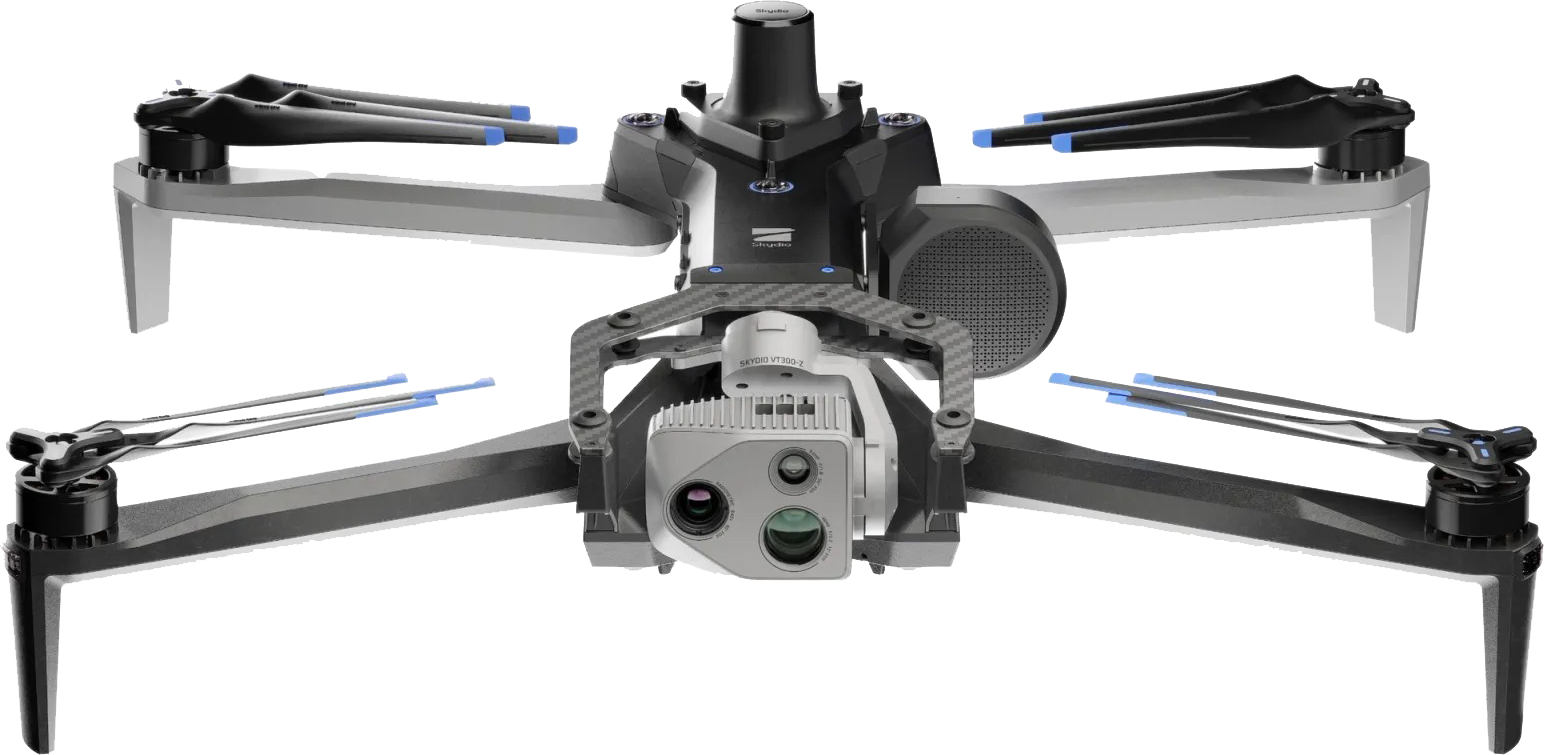
Skydio X10
|

modules Skydio X10 |
|
In 2023, the American manufacturer presented the Skydio X10, "the next evolution of aerial intelligence" according to the manufacturer, a robust and versatile drone designed for professional missions in complex environments, intended for industry, rescue and the military. Its characteristics make it a competitor to Parrot's Anafi USA and AI and DJI's Matrice.
The Skydio X10 can carry two 3-axis stabilized gimbals with the possibility of upward orientation, the VT300-Z and VT-300L. The VT300-Z is composed of a 46 mm f / 1.8 64 megapixel camera with a FOV of 50 °, a 190 mm f / 2.2 48 megapixel zoom camera with a FOV of 13 ° and a FLIR Boson + 60 mm thermal camera in 640 x 480 pixels. The VT-300L replaces the zoom with a 20mm f/1.95 wide-angle camera with a 1-inch sensor for 50 megapixels with a FOV of 93°, and adds a 1000 lumen flashlight.
The device can be deployed in less than 40 seconds, it weighs 2 kilos and measures 34.5 cm in length. Its arms and three-blade propellers are foldable for easy transport. It has a weatherproof design, with an IP54 certification for use in varied weather conditions (light rain, dust). It operates between -20° and 45°C and up to an altitude of 4570 meters with winds of 43 km/h. Its autonomy is 35 minutes in hovering flight. The GNSS part is based on GPS, Galileo, Glonass and BeiDou.
|
|
Lire plus / Lire moins
The range of the SKYDIO X10 is up to 6 km with the Skydio Beacon (depending on local regulations) and control is done via the Skydio mobile app or via the Skydio Beacon for better range.
|
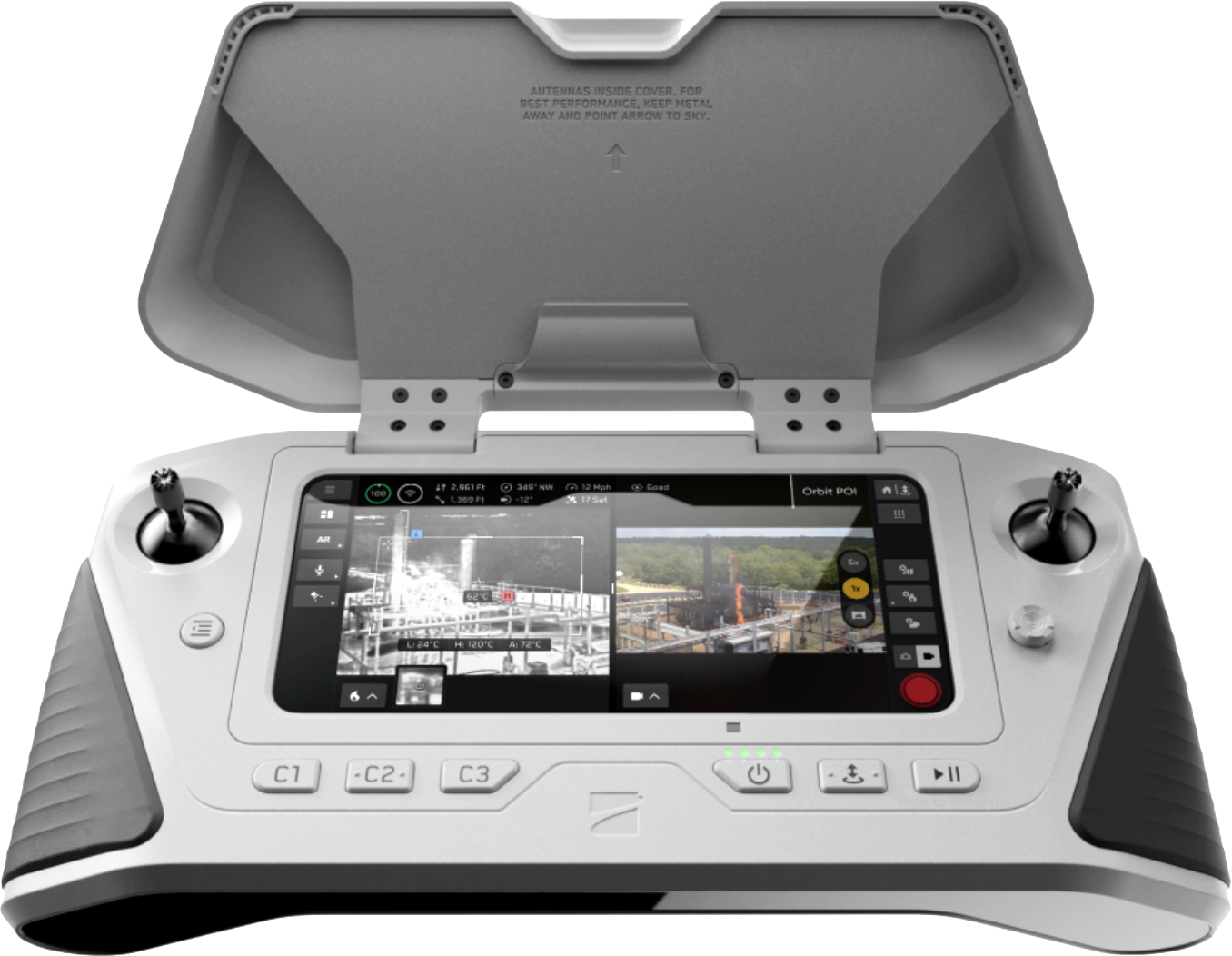
Skydio X10 remote control
|
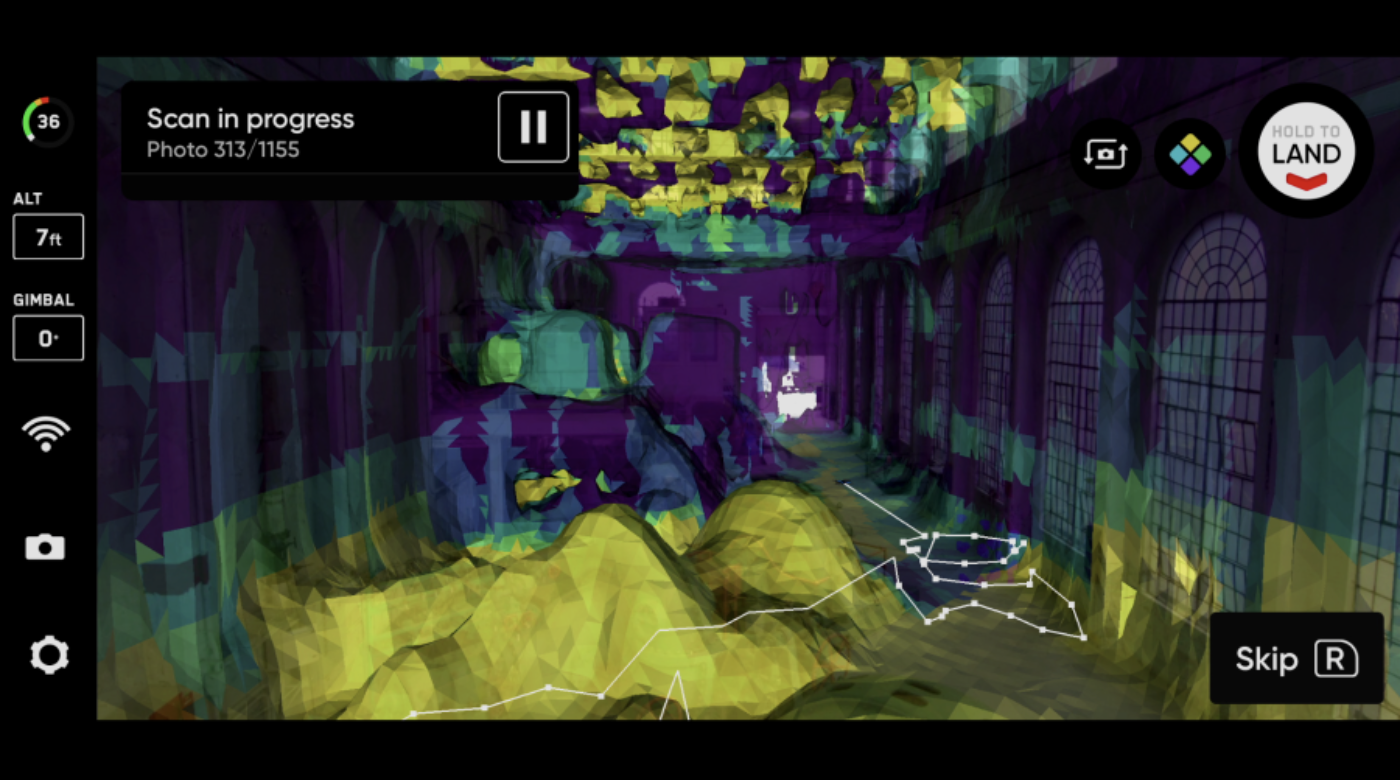
map generated by Skydio X10 |
|
Skydio offers the Skydio X10 Controller and Flight Deck radio control with integrated video feedback screen, or Skydio Remote Flight Deck, an environment for taking control of the drone from a web browser. The connection between the piloting tool and the drone can be classic (2.4 and 5 GHz), with proprietary technology that guarantees a range of up to 12 km, its integrity against hacking attempts, and is distinguished by its reliability in saturated environments. But the Skydio X10 can also benefit from a 5G connection, to pilot the device from anywhere on the planet that is covered by 5G.
Skydio emphasizes the artificial intelligence of the Skydio X10, supported by the computing capacity on board the device. The X10 draws on the experience of previous Skydio models to use the images filmed by the 6 wide-angle cameras intended to model the drone's environment in real time. The principle allows for effective obstacle detection and avoidance in all directions. Skydio has chosen an Nvidia Jetson Orin GPU which, according to the brand's spokespersons, allows 10x more computing power and 10x more pixels taken into account to automate flights. Skydio's algorithms allow, with the help of thermal images, to model an environment in the dark and move around in it.
Skydio offers a new version of its Spatial AI Engine which facilitates the creation of 2D maps and 3D models in real time. Or in formats compatible with 3D processing tools such as Pix4D, Bentely iTwin Capture, DroneDeploy, ESRI SiteScan.
|
The Skydio X10 is designed to accommodate additional accessories, with 4 mounting points. Enough to install microphones, a parachute, a lamp, a RTK GPS, sensors for night flights, with a maximum weight of 340 grams
The Skydio X10D model is essentially an offline variant of Skydio's X10 platform with advanced artificial intelligence. It has a new feature called dynamic channel switching that helps operators monitor signal interference and switch to a clearer channel to improve the quality of the wireless transmission signal during flight. It shares many features with the X10 but has notable differences, particularly in terms of imaging capabilities and robustness for specific missions, namely:
an integrated thermal camera, in addition to the standard RGB camera, a high-precision LIDAR sensor for better 3D modeling of environments, increased robustness with IP67 certification (water and dust resistant).
In the USA, the Skydio X10 is available from $ 16,000 and in November 2024 Skydio acquired 114 patents after GoPro.
En lire plus
2024 - The success of a modern weapon
|

Ukrainian vampire drone
|
Until now, aircraft have been at the forefront of all major military campaigns, but “the use of drones and even commercial satellites have redefined modern warfare.” Long reserved for anti-terrorist operations carried out by Western militaries, unmanned aircraft (or UAVs in English) are on the verge of becoming a centerpiece of all arsenals, including African ones. Drones have become an essential and cheap weapon used by armies and terrorists.
The Ukrainian conflict is the first major conflict to see the massive use of autonomous drones, both on the side of kyiv and Moscow. In Ukraine, small civilian drones are used to destroy tanks, for example. kyiv uses 100,000 per month and plans to produce 1 million per year.
The Ukrainian Vampire drone is equipped with a thermographic calera and can carry up to 15 kg of payload.
The Israeli-Palestinian conflict also makes significant use of drones. In the Red Sea, the drones launched by the Houthi rebels cost $20,000 each, a missile to shoot them down costs $1 million.
Turkey, Iran, Israel and China are exporting more and more drones to meet global demand. |
As information on the subject becomes more and more accessible, the interest in this page becomes less and I will no longer update it regularly.
2024 - drones used in Ukraine and Gaza
We now find excellent articles on drones such as in the February 22, 2024 issue of the French magazine Challenges which deals with drones used in Ukraine and in Gaza, among these:
|

drone TB2
|

drone Lancet-3
|
The Turkish TB2 drone has a range of 150 km and a maximum payload of 700 kg.
"symbol of Ukrainian resistance and a real star among the local soldiers who dedicated a song to him. The TB2 allowed Kiev to inflict great material and human damage on Russia at the start of the war, produced by the Baykar company, of Recep Tayyip Erdogan's son-in-law, it has however been used less recently. The Ukrainian army has opted in particular for even more low-cost machines."**
The Russian Lancet-3 drone has a range of 40 km and a maximum payload of 5 kg.
“This explosive drone, which is launched via a spring-loaded catapult, has established itself in recent months as a weapon of choice for Moscow in Ukraine. Used for the first time in Syria in 2019, it costs between $20,000 and $40,000 , it was designed by the Kalashnikov group. Its low-cost manufacturing allows it to be little affected by Western sanctions."**
|

drone Mohajer 6
|

drone Skylark-3
|
The Iranian Mohajer-6 drone is, along with the Shahed-136 drone, also of Iranian manufacture, one of the most used by the Russian army in Ukraine. It has a range of 2000 km and a payload of 600 kg.
"multi-purpose, the Mohajer-6 can fly up to 200 km/h and carries out surveillance and combat reconnaissance missions, it can be armed with four bombs."**
The Israeli Skylark-3 drone has a range of 20 to 40 km and a maximum payload of 7.5 kg.
T
"Just like the Israeli Sparc reconnaissance drone, it is widely used by the IDF in Gaza. The Skylark-3 from Elbit Systèms has an optronic ball supplied by Israel Aerospace industries which allows it to scan the very dense urban network in real time. of Gaza, and in particular the countless tunnels where Hamas fighters are sheltering."**
The DJI Magic 3, is “used both for surveillance purposes and for kamikaze attack by the Russian and Ukrainian armies. »**
2024 - Sukhoi S-70 Okhotnik-B
|

drone Sukhoi S-70 Okhotnik-B
|

drone Sukhoi S-70 Okhotnik-B with Soukhoi 57
|
The Sukhoi S-70 Okhotnik-B drone is a sixth-generation Russian stealth heavy combat drone developed by Sukhoi and MiG.
It is designed to fulfill the role of “loyal wingman” for the Russian Su-57 fighter plane. Its weight is around 20 tonnes, with a wingspan of around 14 meters. Propulsion is provided by a single Saturn AL-31F turbojet.
It would be capable of flying at a speed of 1,000 km/h while carrying 2.8 tonnes of ammunition, distributed in its two holds. As for its autonomy, it would be 6000 km.
The S-70 Okhotnik appears more like a light unmanned fighter than a drone in the Western sense of the term.
|
2023 - Update on the Ukrainian war
In June 2023, the newspaper Le Monde reported the massive use of drones in the Ukraine Russia war. More than 10,000 drones have been shot down since the start of the conflict. this impressive figure is due to the fact that many drones are used by the troops on the ground, in order to know the position of the enemy. This was obtained by massive use of low-cost drones, often from the manufacturer DJI. The lifespan of these drones used by the troops is low, in the order of three to four flights, both on the Ukrainian side and on the Russian side.
This very significant use of drones constitutes a first for military operations and a turning point, it now seems unavoidable that future conflicts will make increasingly significant use of drones both for directly military purposes and for military purposes. observation. All countries will therefore learn from this conflict.
This situation has led Ukraine to develop its own drone design and manufacturing capabilities. We can think that once peace returns, the skills acquired will be used to create other military drones, see civilian drones.
|

Iranian Shahed 136 drone
|
|
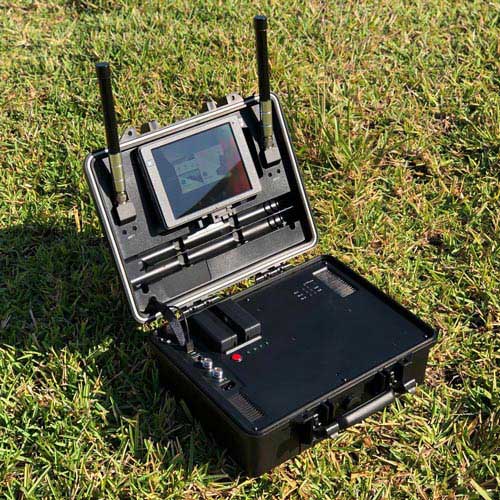
DJI Aeroscope system
|
|
During the Russo-Ukrainian War:
In October 2022, Russia used Iranian Shahed-136 suicide drones to bomb the cities of kyiv (Kyiv), Lviv, Dnipro and Zaporizhia.
The Shahed 136 is a suicide drone that is 3.5m long with a wingspan of 2.5m; it flies at over 185 km/h, weighs around 200 kg and costs around $20,0000. It is built in Syria.
It has a conventional MD 550 engine, a Chinese copy of the German Limbach L550e6 aircraft engine.
It reaches its target by GPS coordinates, entered before takeoff. It then evolves in autonomy, flying quite low and reaching a target which is necessarily fixed at a few hundred kilometers.
|
In February 2022, the Ukrainian government mobilized civilian drones and webcams to monitor the advance of Russian troops in the city of Kyiv.
In March, the Ukrainian government tried to get a Chinese civilian drone tracking system blocked, saying the Russian military is hijacking the technology, dubbed AeroScope, to target drone pilots and civilians with its missiles.
Ukraine has used Turkish Bayraktar TB2 drones purchased by Ukraine from Turkey in recent years and NATO has deployed RQ-4D drones, derived from the American Global Hawk Block 40, operational since 2019 as part of the AGS (Allied Ground Surveillance Capability) system, a program whose European member countries are Bulgaria, the Czech Republic, Estonia, Latvia, Lithuania, Norway, Poland, Romania, Slovakia and Slovenia.
2022 - Eurodrone
|

drone eurodrone
|
|
Berlin, Madrid, Paris and Rome have signed a check for 7 billion for the launch of the Eurodrone, controversial competitor of the Reaper which should be operational at best in 2029. Twenty devices are planned: seven systems for Germany, five for Italy, four for France and four for Spain.
This drone will reach 11 tons and 30 meters wingspan, which will require large hangars and will increase the cost per hour of flight, while its unit price is already at 118 million euros.
According to the weekly magazine Challenges, this drone is the object of a difficult collaboration of the industrialists and the divergent objectives of the States.
After having presented each of the different projects and having disputed the leadership, Airbus, Dassault and the Italian Leonardo have jointly piloted the project since 2015, a project which has already suffered several delays: Berlin demanded a drone with two engines, to be able to fly over inhabited areas in Germany with greater safety, while France, which wants to use the machine in its external theaters of operations, wanted a single engine, to reduce operating and maintenance costs. In the end, Germany prevailed. On the other hand, the chosen engine is the Catalyst from the Italian Avio, a subsidiary of the American group GE.
Finally, the Ukrainian conflict has shown the interest of small drones, such as the Turkish TB2, which are "only" worth 5 million dollars each.
|
>
2021 - Kargu-2 drone "allowed to kill"
|
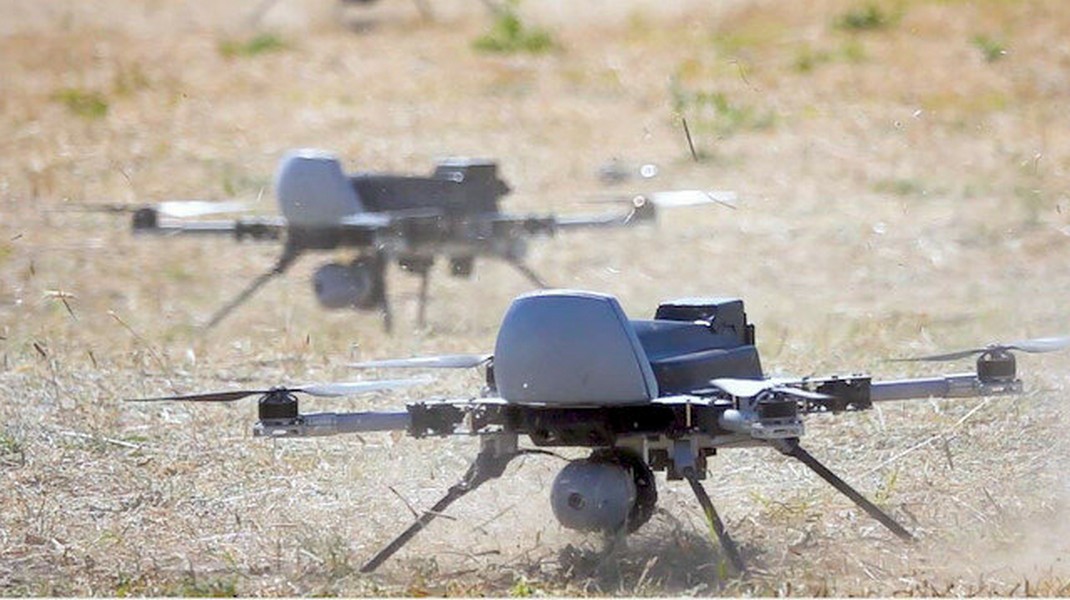
Turkish drone Kargu-2
|
|
According to an UN report, the Kargu-2 drone is the first drone to attack targets, without human intervention. This report considers “that "ranger munitions drones” are a lethal autonomous weapons systems. This deserves to be underlined insofar as the United Nations has been debating since 2014, within the framework of the Convention on Certain Conventional Weapons, the place of lethal autonomous weapons systems and whether their use should be regulated, limited or prohibited."
The Kargu-2, produced by the Turkish company STM, is a 15 pounds quadcopter with a top speed of around 90 mph and a range of half an hour. In standard mode, it is controlled directly by an operator from up to six miles away; When a target is spotted, the drone locks into it and dives down, destroying it with an explosive charge.
Kargu-2's three-pound warhead comes in three varieties, an explosive / fragmentation version for personnel and light vehicles, a thermobar version for destroying buildings and bunkers, and a shaped charge for heavy armor. The Kargu-2 can safely return to the operator for reuse if no targets are found.
The drone is equipped with a LIDAR, a daytime camera and infrared imagery. it is very autonomous and is able to travel a route and use algorithms and facial recognition to locate, track and identify targets without human assistance. |
2020 - Boeing Loyal Wingman
|

Boeing Loyal Wingman
(Click on the image to see the video)
|
|
The Boeing Loyal Wingman drone is the first unmanned aircraft outside the USA.
This drone, equipped with artificial intelligence, is able to take the initiative of the combat itself, without intervention from the operator at ground. Three drones have been manufactured by Boeing Australia for the Royal Australian Air Force (RAAF) which will test them in flight in February 2021. The Loyal Wingman is the basis for future unmanned team planes that will be developed for the air forces worldwide as part of the Boeing Airpower Teaming System program.
The Loyal Wingman is 11.7 meters long and boasts a range of 3,700 kilometers. Its main mission is to escort planes piloted by humans. In addition, it has a removable nose, interchangeable according to the missions. This nose of 2.60 meters and with a capacity of 147.483 cubic cm contains the main sensors and technological equipment of the drone.
Its price, two million dollars, is very low compared to a fighter jet and is relatively affordable compared to its competitors already in the market such as the Kratos XQ-58 Valkyrie.
Drones are therefore now "lethal autonomous robots (RLA), so the warrior ethic is upset: are we capable and should we accept that an artificial intelligence can make the decision to kill a man?". |
2020 - Black Hornet, the micro-drone
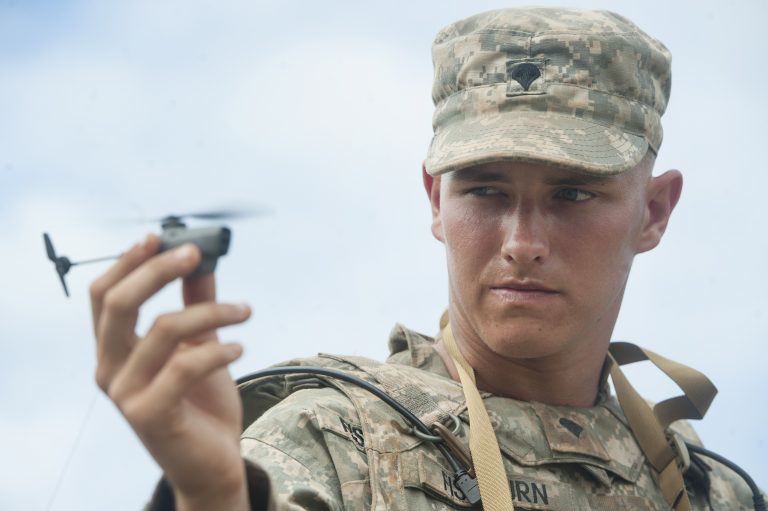
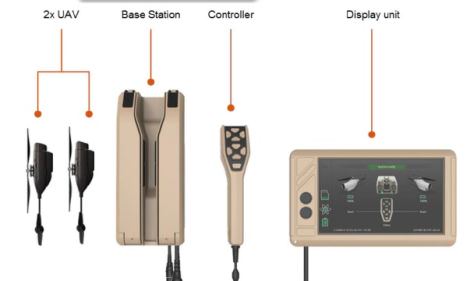
A soldier holds a PD-100 mini-UAV during the PACMAN-I experiment in Hawaii. - Individual PD-100 Equipment for soldier.
Besides the Predators and others Reapers, large unmanned aircrafts, the US Army uses also, as the CIA do, a small UAV called PD-100 "Black Hornet". It is a nano-UAV developed by the Norwegian company Prox Dynamics, a subsidiary of FLIR, an US company. Its features and performances make it ideal for a glimpse of a tactical situation or even exert monitoring movements of an opponent in any discretion, especially in urban areas.
Weighing only 25 grams in charge, the Black Hornet is 16 cm long (hence the name "nano-UAV"). It has an autonomy of 20 to 30 minutes and can flight at a speed of 5 meters per second at 10 meters high, it has a chemical or thermal sensor and 3 high resolution cameras: one attached to the front, a second permitting rotation of 45° and a third film for the floor. Recently, an infrared sensor may replace one of them for night missions. It is both very handy and discreet thanks to its electric motor and small size. It can be controlled manually or used in autonomous mode with its autopilot associated with an artificial intelligence taking into account objects, faces or specific situations to adapt his flight profile to the mission. The Version 3 can now evolve without having a GPS connection. It is charged about $ 46,000.
In Afghanistan, it has been used successfully by the British military for the recognition of enemy fighters hidden in a building. It is estimated that some 8,000 units were manufactured and that the Black Hornet is used by thirty countries. The Black Hornet 3 already equips the US and Australian armies. Since 2016, the French army has equipped its troops participating in Operation "Barkhane" in the Sahel and Sahara Black Hornet models of previous generation and the French army ordered now Black Hornet model 3 for $ 89 million.
2019 - military drones
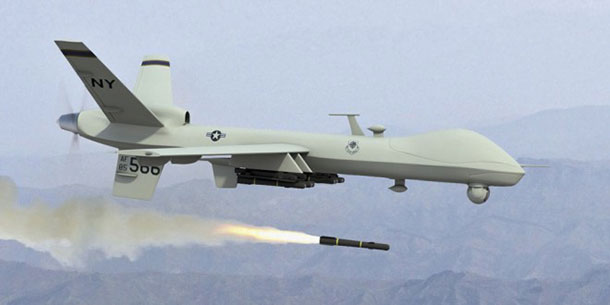
armed Reaper UAV
Use of UAVs increases in recent years and is now on the way to being used in all the world's armies and may be also by terrorist organizations.
Use of this new form of weapon provokes many debates on their legality or as new component of dehumanized war.
Like all new techniques that improve killing at distance, it is more controversial because this decision to kill could eventually not be taken by men but by a programmed system (AI).
Read the excellent web paper part 1 part 2 of Léonard Lifar in "Les Yeux du Monde".
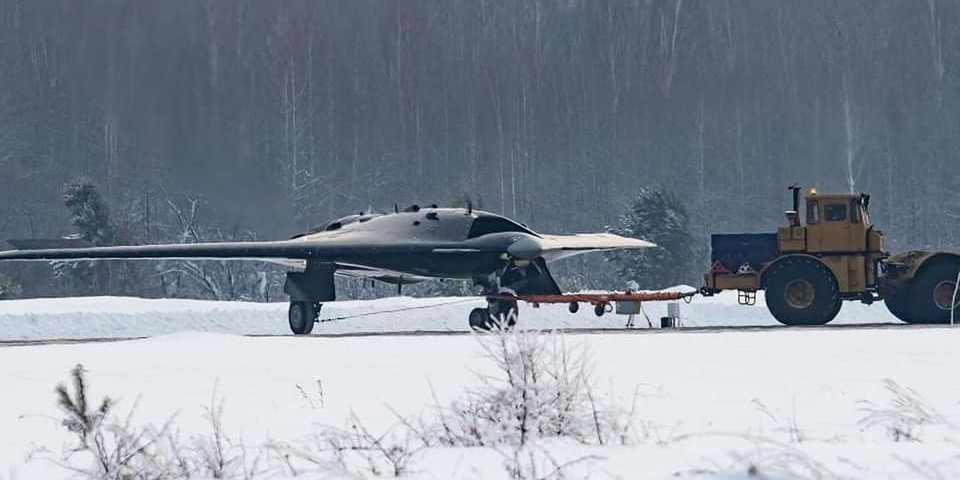
drone russe Okhotnik
The new Russian heavy combat drone Okhotnik , with a mass of about 20 tons, developed by Sukhoi in collaboration with the MiG aircraft construction, will have several missions to accomplish, including the breakthrough of the enemy DCA.
Acting alongside the fifth-generation Su-57 fighter, Russian heavy-combat drone Okhotnik is set to break through the enemy's DCA, Russian media reports said. One of the drone's missions will be to break through the air defense to allow the pilot aircraft to enter, each Su-57 should fly with several drones. The Su-57 crew will be able to control the Okhotnik to allow both aircraft to fly synchronously.
The drone will be tested in flight in spring 2019, as announced by Russian Deputy Minister of Defense Alexei Krivoruchko.
 the hypersonic Chinese WZ-8 drone |
|
 Chinese drones at Malan air base in October 2019 |
|
 the Chinese Divine Eagle drone |
China, which exports its drones worldwide, has introduced new drones.
The huge military parade that took place in Beijing on October 01, 2019 showed two drones Wuzhen 8 (WZ-8).
This high-speed Chinese drone, which would have flown for the first time in September 2015, is launched aloft by a host aircraft, most probably the H-6, the drone then starts its combined cycle turbojet engine to accelerate speed subsonic at high supersonic speed. Provisionally identified as the WZ-8, it is powered by two engines, but the absence of air intakes indicates that it is not breathing. it is equipped with a conventional landing gear.
The Divine Eagle drone is a High Altitude Long Endurance (HALE) drone that will serve as an anti-stealth AEW platform. It’s a double fuselage drone that is over 15 meters long and about 42 meters wide; it is designed to evolve at high altitude, with significant finesse. This 15-ton device is partially made of composite material. the Chinese would have installed large sensors, probably VHF/UHF antennas, if the anti-stealth use of this drone is confirmed.
A unit specializing in the training of drone pilots is established at the Malan air base at 3,000 km from Beijing.
On October 30, 2019, according to satellite images, no less than twenty drone models lined up on the tarmac of the air base located in Xinjiang province. We can easily distinguish several drones that were present in Beijing a month ago, but also others that have remained in the shadows so far. We can cite for example the famous "Divine Eagle", very characteristic by its double fuselage cell, which would be an airborne detection and command drone (AEW & C). Or the strategic surveillance drone WZ-7 / EA-03 , easily recognizable thanks to its rhomboid wings, which was deployed massively in Tibet during the Doklam conflict in 2017, and this year in the provinces of Jilin on the border with North Korea.
 the Chinese Wing Loong UAV |
|
 nEUROn : the European demonstrator UAV |
|
 RQ-170 Sentinel Unmanned Aerial Vehicle |
The Chinese Wing Loong UAV is a combat UAV (MALE) developed by the AVIC firm that looks like the American MQ-9 Reaper but with ammunition carry limited to four points of attachment. It is less efficient than its Western counterparts, particularly in terms of its monitoring and recognition systems, but is also much cheaper. The firm already has clients from the Middle East, including Saudi Arabia and Iran.
A new version was presented at the Paris Air Show in 2017, the Wing Loong II can carry a total mass of 4.2 tons. It has six points of transport to carry air-ground and sea missiles and bombs.
France will arm five of its six MQ-9 Reaper UAVs. In addition, the French Navy is interested in the potential of a future combat UAV embarked on an aircraft carrier via the demonstrator nEUROn . This UAV is 9 meters long with a wingspan of 12.5 meters and a mass of 7 tons. It is the first European UCAV, with two bunkers each designed to house a 250 kg bomb. It is the fruit of a cooperation led by France and Dassault Aviation as prime contractor, with five partner countries and their manufacturers.
The Lockheed Martin RQ-170 is an American reconnaissance UAV, with a design similar to the nEUROn, flying since 2009 in the operation theaters in Afghanistan, Korea and Iran. One of these stealth UAVs was "captured" on December 4, 2011 by Iranian forces.
pierre j.

some military UAVs




























